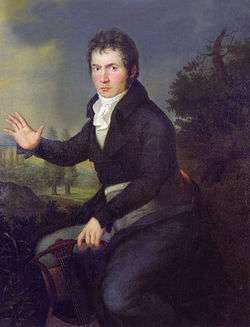Piano Sonata No. 21 (Beethoven)
Beethoven's Piano Sonata No. 21 in C major, Op. 53, known as the Waldstein, is one of the three most notable sonatas of his middle period (the other two being the Appassionata, Op. 57, and Les Adieux, Op. 81a). Completed in summer 1804 and surpassing Beethoven's previous piano sonatas in its scope, the Waldstein is a key early work of Beethoven's "Heroic" decade (1803–1812) and set a standard for piano composition in the grand manner.
| Piano Sonata No. 21 | |
|---|---|
| by Ludwig van Beethoven | |
 Portrait of Ludwig van Beethoven (ca. 1804 – 1805) | |
| Other name | Waldstein |
| Key | C major |
| Opus | Op. 53 |
| Form | Piano sonata |
| Composed | 1804 |
| Dedication | Count Ferdinand Ernst Gabriel von Waldstein |
| Movements | Three |
The sonata's name derives from Beethoven's dedication to his close friend and patron Count Ferdinand Ernst Gabriel von Waldstein of Vienna. Like the Archduke Trio (one of many pieces dedicated to Archduke Rudolph), it is named for Waldstein even though other works are dedicated to him. It is also known as L'Aurora (The Dawn) in Italian, for the sonority of the opening chords of the third movement, thought to conjure an image of daybreak.
It is considered one of Beethoven's greatest and most technically challenging piano sonatas. The first section of the rondo requires a simultaneous pedal trill, high melody and rapid left hand runs while its coda's glissando octaves, written in dialogue between the hands, compel even advanced performers to play in a simplified version since it is more demanding to play on the heavier action of a modern piano than on an early 19th-century instrument.
An average performance of the entire Waldstein lasts about twenty-five minutes.
Movements
The Waldstein has three movements:
The first and last movements of the sonata are the most substantial, each taking about 11 minutes to perform.
I. Allegro con brio
The first movement is in sonata form: it has a repeated exposition with two subject groups, a development section, a recapitulation and a coda.[1]
The movement opens with repeated pianissimo chords in a straightforward but anxious rhythm, devoid of melody for two bars:
It then swiftly ascends, followed by a three-note descent in the middle register and a four-note descent in the upper. This phrase is then repeated starting on B♭ major – a whole tone lower – a device Beethoven also used for the opening of the Sonata No. 16 in G Major (Op. 31 No. 1). After a half cadence to the dominant (G major), the opening phrase returns again but this time in a tremolo variation.[2] The second subject group, marked dolce, is a chordal theme in E major, the mediant key. Modulation to the mediant for the second subject area is another feature shared by this sonata and the Sonata No. 16.[2] Beethoven would employ the same shift again in later works (in the Hammerklavier Sonata, for example).
For the recapitulation, Beethoven transposes the second subject into A major, quickly changing into A minor and then back to C major for the coda.
II. Introduzione. Adagio molto
The Introduzione is a short Adagio in 6
8 time that serves as an introduction to the third movement. This replaced an earlier, longer middle movement, later published as the Andante favori, WoO 57. The music gradually gets more agitated before calming down to segue into the rondo.
III. Rondo. Allegretto moderato – Prestissimo
The rondo begins with a pianissimo melody played with crossed hands that soon returns fortissimo, over daringly fast scales in the left hand and a continuous trill on the dominant in the right, as described above. The second theme, a series of broken chords in triplets, is soon interrupted by a turbulent section in A minor that foreshadows the central episode.
The music returns to C major and the sweet theme is repeated, followed by a series of staccato octaves in C minor that mark the start of the central episode, one of the few cases where such a melodic change is seen, a tactic repeated in larger works like the Emperor Piano Concerto. Soon the octaves are accompanied by swirling triplets in the left and then the right hand. The music grows more tense and eventually reaches a cadence in C minor. The next section brings back the opening theme in chords and further develops it: it appears in A♭ major (bars 221–224), then F minor (225–228) and then D♭ major (229–232); it is fragmented into shorter phrases (233–238) and then transits into a quiet section with major 7th arpeggios, returning after much drama to the C major theme played fortissimo.
The second theme reappears, followed by another characteristic long line of beautiful dance-like music. Another series of fortissimo chords announces a short, delicate pianissimo section: the movement seems to die away but then unexpectedly segues into a virtuosic prestissimo coda that plays with the various themes of the movement, ending in a triumphant rush of grandeur.
References
- Tarasti, Eero (1991). "Beethoven's Waldstein and the Generative Course". Indiana Theory Review. 12: 103.
- Rosen, Charles (2002). Beethoven's Piano Sonatas: A Short Companion. 1. Yale University Press. p. 180. ISBN 0300090706.
External links
| Wikimedia Commons has media related to Piano Sonata No. 21 (Beethoven). |
- Piano Sonata No. 21: Scores at the International Music Score Library Project (IMSLP)
- Lecture with clips of performance by András Schiff and why he thinks it is "one of the greatest pieces of music there is".
- Waldstein Sonata on YouTube, by Mikhail Pletnev, with score
- Recording by Paavali Jumppanen, piano from the Isabella Stewart Gardner Museum